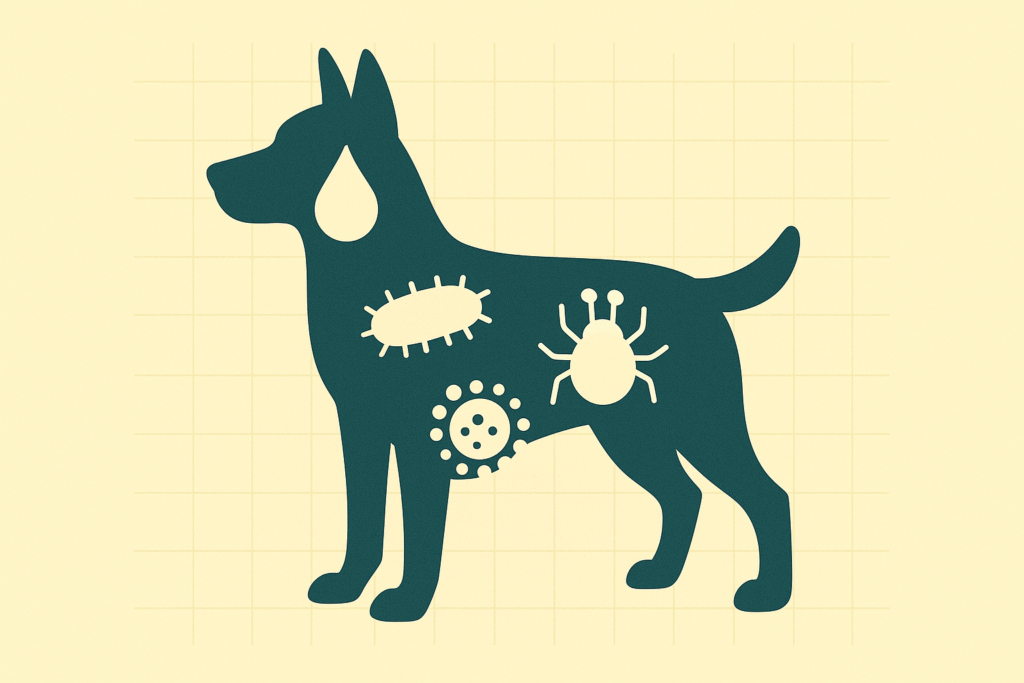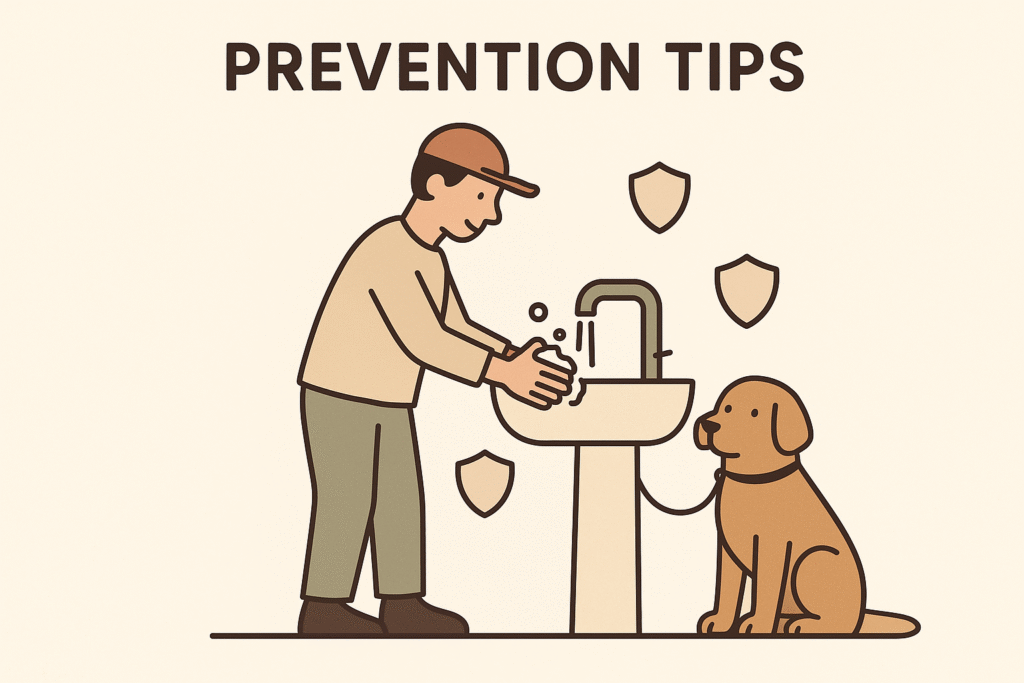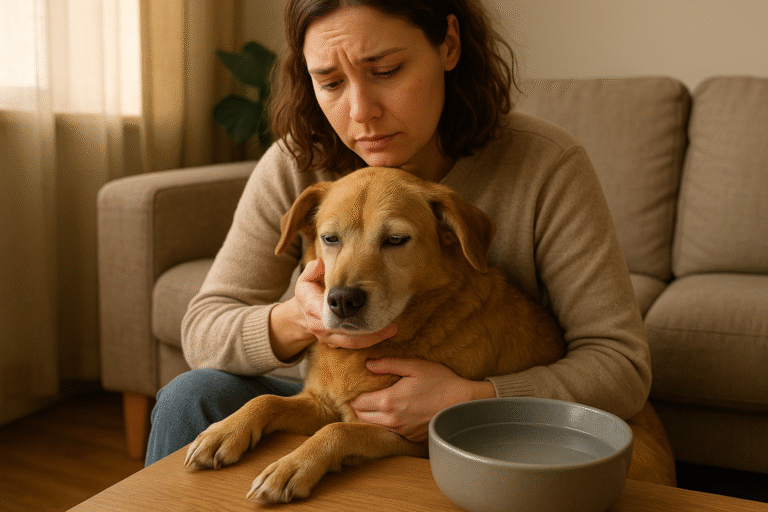
Diseases Dog Owners Can Catch from Their Dogs: A Comprehensive Guide
Owning a dog brings immense joy, companionship, and unconditional love. However, it also carries certain health risks. In particular, diseases dog owners can catch—known as canine zoonoses—are transmitted from dogs to humans. Understanding these zoonotic diseases from dogs and how to prevent them is crucial for every pet owner. This guide covers the most common dog-transmitted diseases, their symptoms, treatment options, and practical tips on preventing dog-borne illnesses.
Table of Contents
ToggleIntroduction
Owning a dog can improve mental and physical well-being. However, it is important to recognize potential health hazards. Dog-to-human disease transmission occurs through bites, scratches, saliva, feces, urine, and even close contact. By learning about these pet owner infections, you can keep your family and furry friend safe.
What Are Canine Zoonoses?
Canine zoonoses are illnesses that jump from dogs to humans. They are a subset of zoonotic diseases, which include infections from various animals. Most zoonoses from dogs arise due to close contact, inadequate hygiene, or unvaccinated pets. While serious cases are rare, the consequences can be severe. Therefore, awareness and prevention are key.
Bacterial Infections
Leptospirosis
- Transmission: Contact with contaminated water or soil via dog urine.
- Symptoms: High fever, headache, muscle pains, vomiting, and jaundice.
- Treatment: Antibiotics (doxycycline or penicillin). Early treatment reduces complications.
- Prevention: Vaccinate dogs annually and avoid stagnant water sources.
Salmonellosis
- Transmission: Ingestion of contaminated dog food, feces, or surfaces.
- Symptoms: Diarrhea, abdominal cramps, fever, and dehydration.
- Treatment: Hydration and antibiotics in severe cases.
- Prevention: Practice proper handwashing after handling dog food or waste.
Campylobacteriosis
- Transmission: Exposure to infected feces or raw dog food.
- Symptoms: Bloody diarrhea, fever, and abdominal pain.
- Treatment: Usually self-limiting; antibiotics if severe.
- Prevention: Cook dog food thoroughly and sanitize feeding areas.
Capnocytophaga Infection
- Transmission: Dog bites or close contact with dog saliva.
- Symptoms: Fever, vomiting, and severe bloodstream infections in immunocompromised individuals.
- Treatment: Immediate medical attention and antibiotics (amoxicillin–clavulanate).
- Prevention: Clean all bites and scratches promptly; monitor wounds closely.
Methicillin-Resistant Staphylococcus aureus (MRSA)
- Transmission: Direct contact with an infected dog’s skin or wounds.
- Symptoms: Skin infections, pus-filled sores, and painful red bumps.
- Treatment: Specialized antibiotics; wound care.
- Prevention: Keep dog skin healthy; avoid sharing towels or bedding.

Viral Infections
Rabies
- Transmission: Bite from an infected dog.
- Symptoms: Fever, headache, paralysis, and encephalitis. Fatal if untreated.
- Treatment: Post-exposure prophylaxis (vaccine and immunoglobulin).
- Prevention: Vaccinate dogs against rabies as per local regulations.
Parvovirus (Indirect Risk)
- Transmission: Although canine parvovirus does not infect humans directly, humans can carry the virus on clothing or shoes.
- Symptoms: N/A for humans; dogs exhibit severe gastrointestinal distress.
- Prevention: Disinfect shoes and hands after visiting dog parks or kennels.
Parasitic Diseases
Toxocariasis
- Transmission: Ingesting microscopic eggs in dog feces.
- Symptoms: Fever, cough, asthma-like symptoms, and vision problems if larvae migrate to the eye.
- Treatment: Antiparasitic medications (albendazole or mebendazole).
- Prevention: Pick up dog feces promptly; teach children not to play in soiled areas.
Giardiasis
- Transmission: Consuming water contaminated with Giardia cysts from dog feces.
- Symptoms: Diarrhea, gas, cramps, and nausea.
- Treatment: Prescription medications (metronidazole or tinidazole).
- Prevention: Ensure dogs are treated regularly for parasites; avoid untreated water sources.
Hookworm Infection
- Transmission: Larvae penetrate the skin from contaminated soil or sand.
- Symptoms: Itchy rash (“creeping eruption”) and respiratory issues if larvae migrate.
- Treatment: Antiparasitic drugs (ivermectin or albendazole).
- Prevention: Wear shoes outdoors; deworm dogs routinely; clean up feces.
Scabies (Sarcoptic Mange)
- Transmission: Direct contact with infested dogs.
- Symptoms: Intense itching and rash, especially at night.
- Treatment: Topical permethrin cream and antihistamines for symptom relief.
- Prevention: Treat infected dogs promptly and avoid close contact until treated.
Fungal Infections
Ringworm (Dermatophytosis)
- Transmission: Direct contact with infected dog or contaminated objects (brushes, bedding).
- Symptoms: Red, circular, itchy patches on skin.
- Treatment: Topical antifungals (clotrimazole) and, in severe cases, oral terbinafine.
- Prevention: Clean and disinfect grooming tools; bathe dogs regularly; isolate infected pets.
Symptoms of Zoonotic Infections
Recognizing symptoms of zoonotic infections early allows for prompt medical care. Common signs include:
- Persistent fever and chills
- Unexplained rashes or skin lesions
- Gastrointestinal distress (nausea, vomiting, diarrhea)
- Respiratory issues (cough, shortness of breath)
- Unusual fatigue or muscle aches
If you notice any of these, seek medical advice and mention dog-to-human disease transmission to your healthcare provider.
How to Avoid Dog-Borne Diseases
Preventing dog-borne illnesses requires consistent habits:
- Hand Hygiene: Wash hands with soap after petting, feeding, or cleaning up.
- Regular Vet Visits: Keep vaccinations and parasite prevention up to date.
- Safe Handling: Wear gloves when scooping waste; clean wounds immediately.
- Proper Food Practices: Avoid raw diets unless supervised by a vet; wash bowls daily.
- Environmental Sanitation: Disinfect living areas, bedding, and toys regularly.

Dog Hygiene and Health Risks
Maintaining your dog’s health reduces risks. Dog hygiene and health risks go hand in hand:
- Brushing and Bathing: Removes dirt, debris, and parasites.
- Oral Care: Controls bacterial buildup that could transfer via bites.
- Flea and Tick Control: Prevents vector-borne zoonoses (e.g., Lyme disease).
- Safe Socialization: Ensure playmates are healthy and vaccinated.
Protecting Yourself from Pet Diseases
Protecting yourself from pet diseases means adopting a holistic approach:
- Educate family members about safe pet interactions.
- Teach children not to kiss dogs or put their hands in their mouths.
- Use protective gear (gloves, masks) when handling high-risk materials.
- Establish a regular cleaning schedule for pet areas.
- Stay informed on emerging common dog-transmitted diseases in your region.
Conclusion
While the bond between dogs and humans is priceless, awareness of diseases dog owners can catch ensures a healthy relationship. Canine zoonoses—from bacterial infections like leptospirosis to fungal issues such as ringworm—can be effectively prevented with proper hygiene, veterinary care, and education. By following the practices outlined above, you’ll reduce the likelihood of pet owner infections, safeguard your family’s health, and continue to enjoy the unconditional love of your canine companion.
Frequently Asked Questions (FAQs)
What are zoonotic diseases and how do they relate to dogs?
Zoonotic diseases are illnesses that can be transmitted from animals to humans. Dogs can carry bacteria, viruses, fungi, and parasites—such as Leptospira, Salmonella, ringworm fungi, and hookworms—that may infect their owners through direct contact, bites, scratches, or exposure to contaminated saliva, feces, or urine.
hich bacterial infections can dog owners catch from their pets?
Common bacterial zoonoses from dogs include leptospirosis (transmitted via contaminated water or soil), salmonellosis and campylobacteriosis (through contact with feces or raw food), Capnocytophaga infection (from dog saliva via bites or licks), and MRSA (through skin-to-skin contact with an infected dog).
Can I get rabies from my vaccinated dog?
If your dog is up to date on its rabies vaccination, the risk of contracting rabies is extremely low. But any bite or scratch from an unvaccinated or unknown-status dog should prompt immediate medical evaluation and, if indicated, post-exposure prophylaxis.
How can I tell if I’ve contracted a zoonotic disease from my dog?
Look out for persistent fever, gastrointestinal symptoms (vomiting, diarrhea), unexplained rashes or skin lesions, respiratory issues (coughing, shortness of breath), or unusual fatigue. If you experience these after close contact with your dog, mention the possibility of canine zoonoses when you see your healthcare provider.
What preventive measures reduce the risk of dog-to-human disease transmission?
- Hand Hygiene: Wash hands thoroughly after handling your dog, its food, or waste.
- Regular Vet Care: Keep vaccinations and parasite preventives current.
- Safe Feeding Practices: Avoid raw diets unless supervised by a vet; disinfect bowls daily.
- Environmental Cleanliness: Promptly remove and dispose of waste; disinfect living areas and bedding.
- Wound Care: Clean any bites or scratches immediately with soap and water, and seek medical advice if needed.
Are puppies more likely to transmit diseases than adult dogs?
Puppies can carry higher burdens of intestinal parasites (like roundworms and Giardia) and are more prone to shedding certain pathogens because their immune systems are still developing. Extra caution and strict hygiene are essential when handling puppies.
Can I still walk my dog in public parks without risking zoonotic infection?
Yes, as long as you practice preventive measures: pick up and properly dispose of your dog’s feces, avoid letting your dog drink from stagnant water sources, and wash your hands after park visits. Keeping your dog’s vaccinations and deworming up to date further minimizes risks.
How often should I deworm my dog to prevent parasite transmission?
Most veterinarians recommend deworming puppies every 2–3 weeks until they are 12 weeks old, then monthly until six months old. Adult dogs typically need deworming every 3–6 months, but frequency may vary based on your dog’s lifestyle and local parasite prevalence.
Is ringworm from dogs dangerous to humans?
Ringworm (a fungal infection) can cause red, circular, itchy patches on human skin. While uncomfortable, it is generally treatable with topical or oral antifungals. Good hygiene—bathing your dog regularly, cleaning grooming tools, and isolating infected pets—helps prevent transmission.
When should I see a doctor about a potential dog-borne illness?
Seek medical attention if you develop any unexplained symptoms—such as fever, rash, gastrointestinal distress, or respiratory problems—especially after a dog bite, scratch, or exposure to dog waste or saliva. Early diagnosis and treatment improve outcomes for most zoonotic infections.
Recent Posts









Related Topics
Copyright © 2025 The Pet Blog – Expert Tips, Care Guides & Fun Facts for Every Pet Lover.

